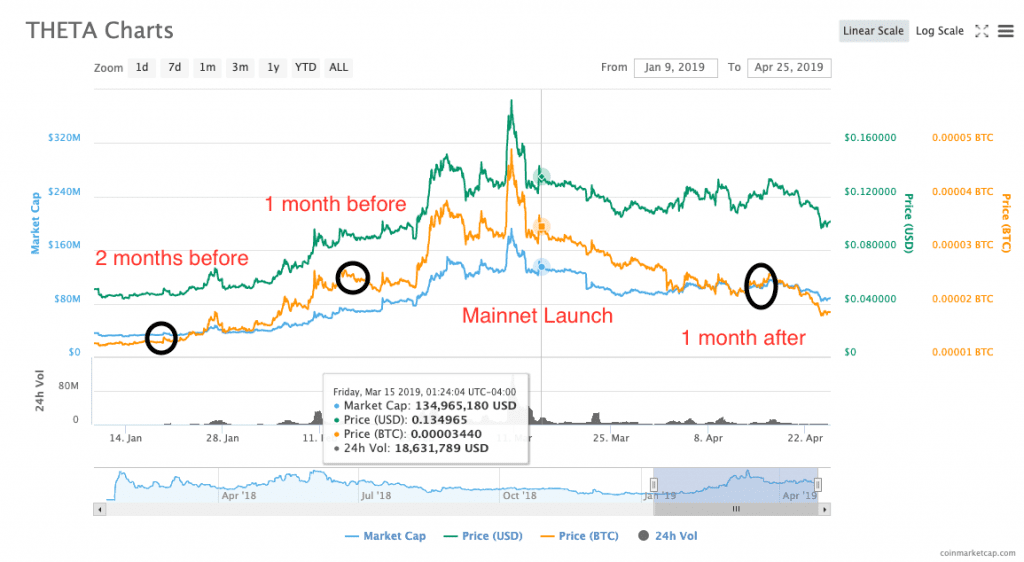Trading The Mainnet: Three Crypto Investor Strategies Analyzed
Buy, sell or HODL? We took a look at three mainnet investment strategies.

Share this article
Last week’s launch of Binance Chain saw the price of BNB increase by close to 30% in less than a week. Binance wasn’t alone; market watchers have seen enormous crypto price swings around announcements and new mainnets, with potential for big losses as well as gains.
That got us thinking: how are traders taking advantage of the anticipation and hype surrounding mainnet launches in crypto?
We’re not experts and we don’t give financial advice; all the same, we’re as curious as anyone else. To satisfy our curiosity, we took a deeper look the data to determine how the traders are playing their hands around a mainnet launch.
To figure that out, we took 28 popular cryptocurrencies which launched mainnets between 2017-2019. Then, we created three imaginary traders, each of whom would use a static investment strategy, and compared their results against a buy-and-hold strategy to see how their investments would pan out.
Let’s meet our three investors:
- Investor A: Buys the coin 60 days prior to the mainnet launch, sells 1 day prior, and then buys back as many coins as possible 30 days after.
- Investor B: Buys the coin 30 days prior to the mainnet launch, sells 1 day prior, and then buys back 30 days after.
- Investor C: Buys the coin 30 days after the mainnet has launched.
Each imaginary trader starts with 1 BTC, and their goal was to accumulate as many altcoin tokens as possible.
Here’s how it turned out:
Strategy A: 38% ROI
Strategy B: 55% ROI
Strategy C: 58% ROI
Based on this model, the simplest strategy is also the most profitable: Investor C ignored the fuss and bought the tokens a month after the mainnet quiets down. Instead of trying to sell at the top, the investor who waited did narrowly better than his peers.
This is likely because of undiversifiable bias in the data, which we’ll come back to shortly. The majority of blockchain mainnet launches happened between June and September of 2018, as all virtual assets were depreciating. Investor C happened to luck out by delaying most investments until after an incredibly bearish alt-season.

But the more successful strategy moving forward might a variation of Investor B’s strategy, at least if she believes markets are trending upwards. There is a clear pattern where coins seem to appreciate in value leading up to the launch of their mainnet, depreciate right after the launch, and then slowly increase in value afterwards. This seems to be a more sustainable strategy based on the data.
Strategy B can also be backtested with different parameters to produce a much higher ROI. For example, with THETA an investor could have generated a 25% higher ROI if they had sold one week prior to the mainnet launch rather than one day before. This doesn’t give us a hard-and-fast rule, but it does provide a useful guideline of what our hypothetical investor may expect.
Can We Draw Any Conclusions?
Moving forward, the biggest lesson seems to be about the pitfalls of panic-buying. Sure, that promising token could be headed for the moon, but it’s likely to spend at least some time on the ground. Even NASA can tell you that.
For example, purchasing BNB 60 days prior to the Binance Chain launch, and selling one day prior, would have made an investor 40% alpha relative to BTC. But don’t cry if you missed that boat; BNB could still depreciate to a much cheaper level after the hype of the mainnet wears off.
One root cause of this trend may be the amount of media coverage that a coin gets prior to its mainnet launch. This makes more investors aware of the project, which encourages more buying, and has a cyclical effect.
If there’s one big takeaway from these data, it’s that FOMO-buying at the height of a mainnet launch appears to be a losing strategy. Many previous projects have accumulated higher market caps prior to a launch, and then depreciated as the hype cycle wore off.
Notes about the data and analysis
-
Weak projects favor Strategy C, because lack of interest after a mainnet causes the coin to diminish in value.
-
The majority of mainnet launch data comes during a bear period for alt-coins.
-
The sample size is small; we just haven’t seen enough launches to make hard and fast conclusions.
-
The alt-market tends to follow the trend of BTC, which makes the data noisy; some spikes in price could have been caused by moves in BTC rather than correlation to a mainnet launch.
-
The three strategies chosen are arbitrary parameters, and were chosen before collecting data. Other hypotheses could generate vastly different data.
-
The data isn’t perfect. Not all coins have a perfect genesis block date; some coins will launch their blockchain and continue working towards decentralizing over time.
-
Trading goals vary from trader to trader, and in this analysis it was assumed that the goal was to accumulate more altcoins rather than more BTC.
